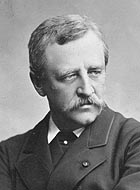Adolf Erik Nordenskiöld
Adolf Erik, Baron Nordenskiöld ( born November 18, 1832 in Helsinki ( Finland ); † August 12, 1901 at Dalbyö today: Municipality Trosa in Södermanland ) was a player in Sweden Baron, a professor in Stockholm, polar explorer, cartographer and travel writer with finland Swedish descent. He was the father of Erland Nordenskiöld and uncle of Otto Nordenskjold. Nordenskiöld beat the first sailors named the Northeast Passage.
Life
Nordenskiold studied in Helsinki (Swedish Helsingfors ) and went to Stockholm in 1857, where he was in 1858 as professor and head of the mineralogical collections. He has since participated in all Swedish scientific expeditions Arctic, of which the first two (1858 and 1861) were under the direction Torells and the following two (1864 and 1868 ) took place under the direction Nordenskiöld.
The fourth expedition, the Swedish State outfitted the strongly built, commanded by Captain Baron von Otter mail steamer Sofia, who at 81 ° 42 ' north latitude until then northerly of a vehicle visited point, reached on September 19, 1868. The archipelago of Svalbard has been studied in detail by these expeditions.
For the Reichstag period 1870-1872 Nordenskiöld was elected to the Second Chamber, where he worked in a liberal spirit. In 1870 he came to Greenland, located about 45 km in the inland one. This trip described Nordenskiold in his work Redogörelse för en expedition till Greenland år 1870 ( Stockholm 1871). The fifth Swedish expedition was under his direction in mid-July 1872 by Tromso from and wintered at Mosselbukta on Spitsbergen (79 ° 53 'north latitude and 16 ° 4' east longitude ), where with some companions in the spring of 1873 he on sled only to the located north of Spitzbergen Seven Islands (Norwegian: Sjuøyane ) and then from there drove back over the inland of the North Lands for winter station.
1875 Nordenskiöld drove through the Kara Sea to the mouth of the Yenisei and repeated this trip in 1876. During the same year he was appointed a corresponding member of the Bavarian Academy of Sciences.
The greatest glory he acquired while by the successful crossing of the Northeast Passage along the northern coast of Siberia 1878/79 on the Auxiliarsegler Vega. This expedition went from Gothenburg on July 4, 1878. After the Vega had bypassed the northern coast of Siberia among many dangers, they froze the end of September 1878 67 ° 30 'north latitude and 173 ° 23' west longitude north-west of the Bering Strait, and was only on July 18, 1879 to continue their journey, at the same time than the Jeannette under Captain George W. DeLong took the unsuccessful attempt to penetrate through the Bering Strait to the north. Beginning of September met Nordenskiöld in Japan and drove from here through the Suez Canal to Europe.
The King of Sweden, Oscar II, Nordenskiöld rose in April in the baron. The report on his epochal journey appeared simultaneously in several languages . On May 23, 1883 Nordenskiöld went to Gothenburg again on an expedition to Greenland, where he landed on 1 July in Auleitsivikfjord in West Greenland. From there he went between July 4 and August 4 on the Greenland ice desert and came there before further than anyone before him. On August 17, the expedition took the return trip and went through the first time the southeast coast obstructing ice to land on the coast. On 9 September, the expedition then met in Reykjavík.
Honors
Different areas of the Spitzberg archipelago Adolf Erik Nordenskiöld are named after: the glacier Nordenskiöldbreen, the bay Nordenskiöldbukta, the river Nordenskiölddelva, the valley Nordenskiölddalen, the coastal region Nordenskiöldkysten, is the pinnacle Nordenskiöldfjellet, the island and the peninsula Nordenskiöldøya Nordenskiöld Land. Add to this the Nordenskiöldinseln in the Kara Sea. Further, according to him, the asteroid ( 2464 ) Nordenskiöld is named.
Permanent exhibition in the Etnografiska Museet in Stockholm
An exhibition space in the Etnografiska Museet in Stockholm, Djurgårdsbrunnsvägen 34 Gärdet, showing the expedition of Adolf Erik Nordenskiöld finds.
The Vega Monument
The Vega Monument was erected (fifty years after the return of the Vega of the Northeast Passage ) before Naturhistoriska Riksmuseet in Stockholm, Frescativägen 40, Frescati on 24 April 1930. It is a work of Ivar Johnsson and shows a black granite block with Copper Three -masted barque Vega.
The Adolf Erik Nordenskiöld - Collection in the Helsinki University Library
The substantiated Nordenskiöld himself Adolf Erik Nordenskiöld - collection was included in the UNESCO list of world cultural heritage list " Memory of the World " in 1997. It is one of the most comprehensive collections of atlases, maps, geographical works, and of travel literature. The Nordenskiold collection contains more than 5,000 works. Especially valuable are the early works of cartography, including printed Ptolemaic atlases and charts.
Quote
With 15 years of Sven Hedin witnessed the triumphal return of the Vega after the initial biking the Northeast Passage.
He describes this in his book My Life as a discoverer as follows:
" On April 24, 1880, Vega ran into Stockholms Ström. The whole city was illuminated. The houses around the harbor flashed in the glow of innumerable lamps and torches. In the castle shone in gas flames, the constellation of Vega. In the midst of this sea of lights slid the famous ship in the harbor. With my parents and siblings, I stood on the mountains of Södermalm, where we had a dominant view. Largest tension had captured me. All my life, I will think back to this day, he was decisive for my future path. From quays, roads, windows and roofs roared thunderous cheers., So I one day come home, 'I thought. "










